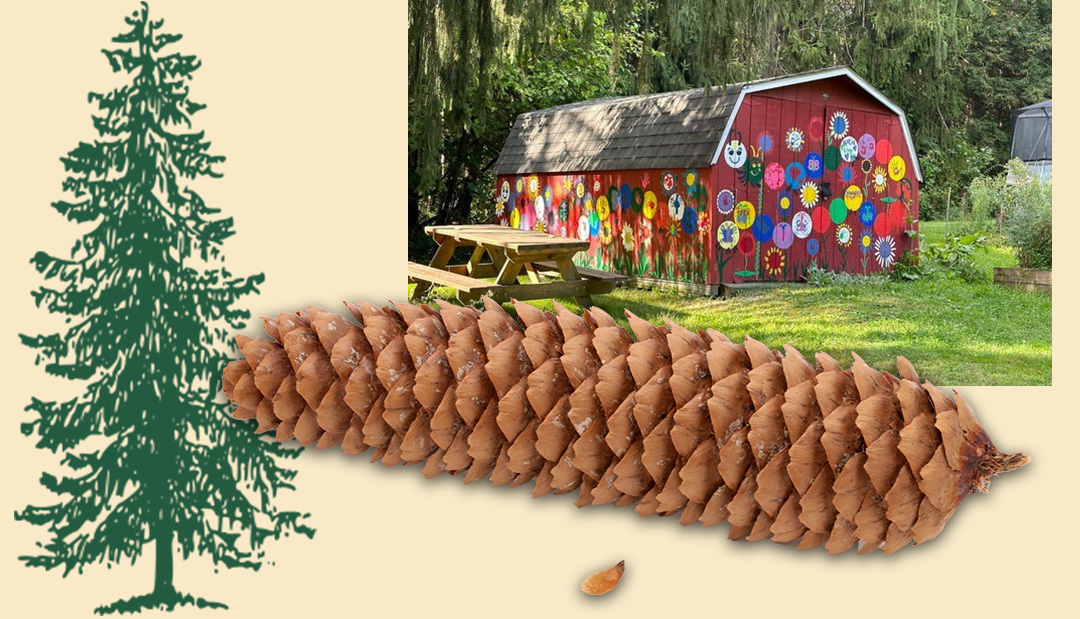Submitted by PAM VARGA, Sahli Park Manager
One of my favorite things at Sahli Nature Park are the majestic Norway Spruce trees growing along the edges of the pond and throughout the park. These towering evergreens with their long sweeping branches provide cool green shade for wildlife and park visitors during the summer. In the fall, their dark green needles provide contrast to the bright reds, oranges and yellows of the other trees around them. The long gracefully sweeping branches covered with winter snow remind me of a flowing white gown fit for an angel or fairy princess.
These fast growing evergreens can reach heights of over 100 feet tall. With their pyramidal shape and pleasant smell, young trees are a popular choice for Christmas trees. Not native to North America, but imported from Europe, Norway Spruce are often planted as a windbreak or a privacy screen. They are also used in reforestation projects. The wood is used for furniture, flooring, building construction and making paper. When it comes to making musical stringed instruments, especially violins, Norway Spruce is referred to as the “king of trees”. The wood is used in making guitars, cellos, mandolins, piano soundboards, and harps. The Wright Brothers’ first aircraft, the Flyer, was constructed from spruce wood. Early explorers made an alcoholic spruce beer from fresh spruce shoots to prevent sailors from getting scurvy, a disease resulting from a lack of vitamin C. Spruce beer was also used by some indigenous people of North America and was popular with early colonists. You can still buy Spruce Beer today.
Norway Spruce can live a long time, even a hundred years or more. The root system of Old Tjikko, a Norway Spruce tree in Sweden, is 9,563 years old! When the tree reaches an age of about 600 years, it dies and a new tree grows from the roots. The tallest Norway Spruce, found in Slovenia, is 204 feet tall.
Trees have leaves, right? Trees need leaves to absorb carbon dioxide from the air, and take up water and minerals from the roots up through the trunk. In the presence of sunlight, green chlorophyll in the leaves uses the water, minerals and carbon dioxide to make a form of sugar which acts as food for the growing tree. So where are the leaves on evergreen trees like the Norway Spruce?The answer is needles. The needles on evergreen trees are actually leaves and serve the same function of making food for the tree.
And what about seeds? Trees make seeds in order to continue their species. Where are the seeds on evergreens? Most evergreens, including the Norway Spruce, are “coniferous”. They make their seeds inside cones ( “pine cones” ). Under each hard scale on the outside of the cone is a seed. When they are ripe, the cones open up and the seeds fall out. Squirrels absolutely love to eat the seeds, but the spruce cones are too big for them to carry. So the squirrels scurry out to the ends of the branches and nip off the cones. The cones fall to the ground where the squirrels can easily feast on the seeds. In the forest, you can find piles of the cone scales and the cores of the cones which remind me of corn cobs. Norway Spruce have the largest cones of all types of Spruces. The cones are usually 6 inches or more in length. Quite meal for a squirrel!
The Norway Spruce at Sahli Nature Park are an important part of the forest ecosystem. In addition to providing food for squirrels and other small mammals, the low growing branches offer shade, shelter and winter cover for wildlife and ground birds such as pheasants. Some species of moth caterpillars feed on the cone scales. Because these trees are so tall, towering above most other trees, they are used as roosting sites for hawks and owls. The dense branches offer nesting sites for songbirds.
The Latin name for Norway Spruce is “Picea abies”. Because they are used as Christmas trees, Norway Spruce are sometimes called the “Pine of Peace”. They are considered to be a symbol of nobility, generosity and peace. The next time you visit the park, take a walk along the trails, look up at the beautiful majestic Norway Spruce and have a peaceful day.
There’s a new critter at Sahli Nature Park! We want to thank the Beaver County Penn State Master Gardener volunteers, the folks at Champion Life Church and the children who attended Meet the Monarchs Day at the park for creating this colorful whimsical caterpillar mural that welcomes visitors to our pollinator gardens.







